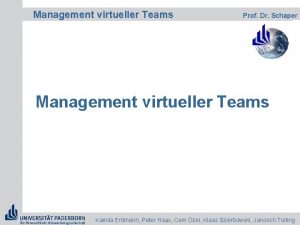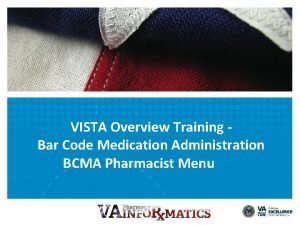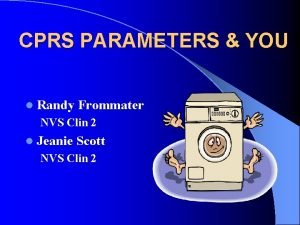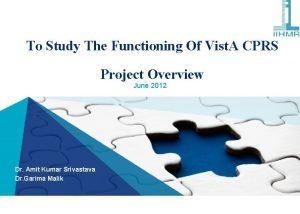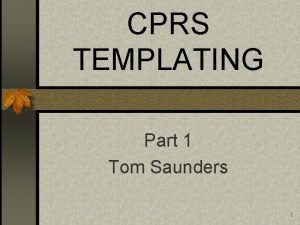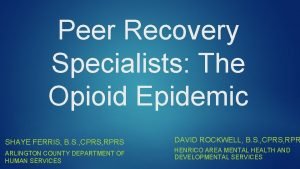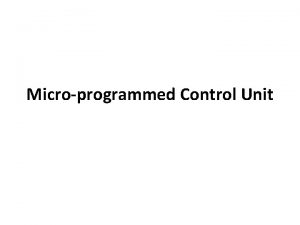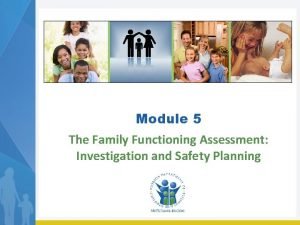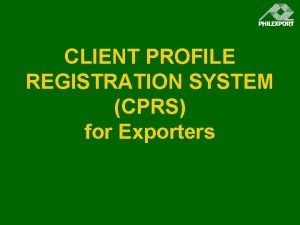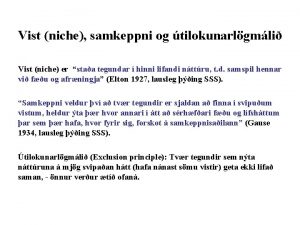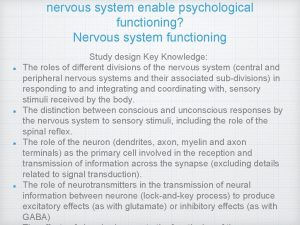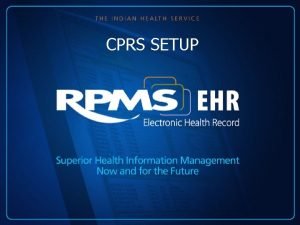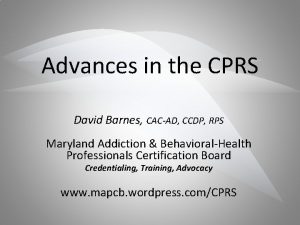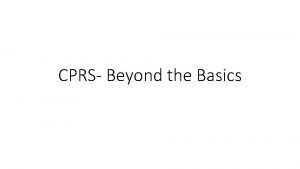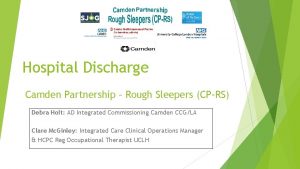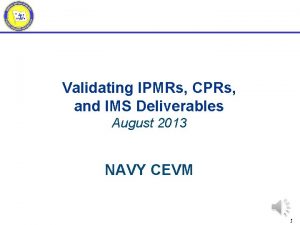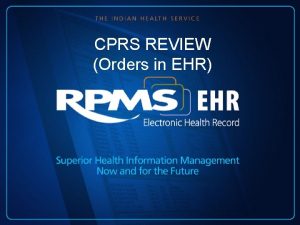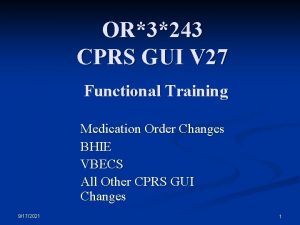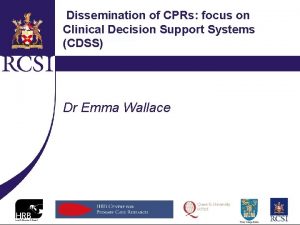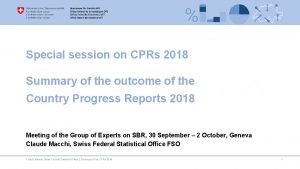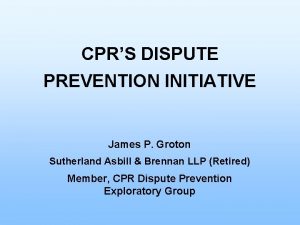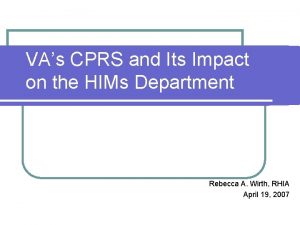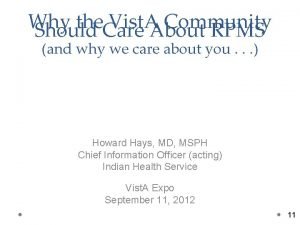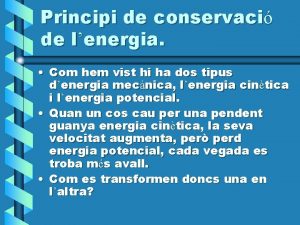To Study The Functioning Of Vist A CPRS
































- Slides: 32

To Study The Functioning Of Vist. A CPRS Project Overview June 2012 Dr. Amit Kumar Srivastava Dr. Garima Malik

Organizational Overview MAX HEALTHCARE Ø Country’s leading comprehensive provider of standardized, seamless and international class healthcare services Ø It is committed to the highest standards of medical and service excellence, patient care, scientific and medical education Ø Max Healthcare operates eight facilities in Delhi & NCR, offering services in over 30 medical disciplines Ø Max Healthcare has a base of over 1600 leading doctors, 4300 employees and 13, 000 patients with number of beds growing to over 1900 in the next two years MARSH 1

GENERAL OBJECTIVE: To Study the functioning of Vist. A CPRS SPECIFIC OBJECTIVES: Ø To study the workflow involved in the module CPRS Ø To identify the relationship of the CPRS with other modules of Vist. A Ø To reach a comprehensive training plan to the hospital customers MARSH 2

SCOPE OF STUDY: Ø To study CPRS in depth, so that will be able to assist end users ( nurses & physicians) while giving hands on training Ø Study can be used for creating user manual, training plan and schedule METHODOLOGY: Ø Observational Ø Interview of end users with close ended structured questionnaire MARSH 3

SUMMER TRAINING PROJECT TIMELINE CCPRS/BCMA HANDS ON TRAINING TO DESIGN AND PLAN SCHEDULE FOR TRAINING PROGRAM TRAINING END USERS REFRESHER SESSIONS PROJECT REPORT DRAFT APRIL 9 TH- APRIL 16 TH- APRIL 23 RD- APRIL 30 TH- MAY 7 TH 13 TH 20 TH 27 TH MAY 4 TH 11 TH MARSH MAY 14 TH- MAY 21 ST- MAY 28 TH- JUNE 1 ST 18 TH 25 TH 31 ST 13 TH 4

Vist. A Ø The Veterans Health Information Systems and Technology Architecture (Vist. A) Ø It is an enterprise-wide information system built around an electronic health record, used throughout the U. S. Department of Veterans Affairs (VA) medical system, known as the Veterans Health Administration(VHA) Ø Vist. A, is an integrated system of software applications that directly supports patient care Ø It has various modules, some of them include laboratory, pharmacy, radiology, Bar Code Medical Administration and CPRS MARSH 5

Vist. A CPRS ØIt is graphical user interface for clinicians known as the Computerized Patient Record System (CPRS), which was released in 1997 ØIt allows health care providers to review and update a patient's electronic medical record ØIt includes the ability to place orders, including those for medications, special procedures, X-rays, nursing interventions, diets, and laboratory tests ØIt provides electronic data entry, editing, and electronic signatures for provider-patient encounters as well as provider orders MARSH 6

Vist. A CPRS in Detail Vist. A – Veterans Health Information Systems and Technology Architecture computer application CPRS – Computerised Patient Record System MARSH 7

PURPOSE OF CPRS To enter Patient Information To review Patient Information CPRS Continuously Update Information when connected. Analyze Patient Data Supports Clinical Decision Making MARSH 8

Record Patient History Enter Problems Enter Diagnosis Enter Treatment Plan Enter Progress Notes Record Allergies Record Adverse Events Request and track Consults Order Lab Investigations Order Medications Order Diets Order Radiology tests Order Procedures Enter Discharge Summaries MARSH 9

Salient Features of Vist. A CPRS COMPUTERISED PHYSICIAN ORDER ENTRY ( CPOE ) CPOE decreases : - 1. Delay in order completion 2. Reduces errors related to handwriting or transcription 3. Allows order entry at point-of-care or off-site 4. Provides error-checking for duplicate or incorrect doses or tests 5. Simplifies inventory and posting of charges MARSH 10

BENEFITS OF CPOE a. Enables doctors to enter prescription, lab test and other orders for patient care straight into a hospital information system b. CPOE decision support includes: automated medication checking, drug dose, allergy, and interaction checking; duplicate order notification; recommendations for pre- or post-administration tests etc v Adverse Reaction Tracking a. Documents patient allergy and adverse drug reaction data b. Alerts the Pharmacy and Therapeutics Committee each time the signs/symptoms are modified for a patient reaction v Clinical Reminders a. Allows clinicians to resolve reminders through dialogs within the CPRS GUI (graphical user interface). Using point-and-click techniques, a clinician can generate text for progress notes, update current and historical encounter data in Patient Care Encounter (PCE), update vital signs, update mental health test results/scores, and place orders 11 MARSH

Difference in Workflows before and after EHR Implementation in Client’s Hospital Before EHR Implementation MARSH After EHR Implementation Orders are sent manually Orders will be send electronically Billing – Pre Consultation Billing – Post Consultation Billing Patient gets Prescription from Physician Patient will collect the Prescription from the front desk after making the payment for consultation Manual Medication Administration to IP patients Bar-coded Medication Administration Trade Names of Medicines Prescribed Generic Names of Medicines Prescribed, New Concept of Cart fill and Unit Dose to be introduced 12

MARSH 13

TRAINING NEED ANALYSIS To get the information of number of end users to be trained To know who are to be trained in which module that is CPRS, Radiology, Lab and Pharmacy and what will be the staff number for the training MARSH 14

ROLES AND RESPONSIBILITIES OF THE TRAINING TEAM AND THE USERS v End User • They should be familiar with the working of the system • They should be able to access, retrieve and enter data in Vist. A • They shall be well versed with the module v. Training Coordinators • They will coordinate the entire training process • They will check availability of trainers , staff , training material and infrastructure MARSH 15

BASIC METHODS OF DELIVERY 1. Individual hands-on Instructor An instructor walks to each user individually to help in performing common tasks and clear their doubts. This is the most expensive method, although potentially the most effective. 2. Hands on class room style instructor-led training MARSH An instructor shows users how the software works and how to perform common tasks, with users performing the tasks themselves in a classroom/lab setting. Each user or pair of users will have a system to practice the software. Classes of 12 -15 are often effective. 16

3. Seminar Style Group Demonstration An Instructor shows users how the software works and how to perform common tasks in a live demonstration. Groups of 20 to 50 are often effective. 4. Computer Based Training CD-based or online ( Web Based ) Self-placed training allows end-users to complete interactive lessons, as per their comfort and this makes them efficient in performing common tasks. The software tests them on their performance and understanding. MARSH 17

CHALLENGES FACED 1. The senior physicians were not co-operative and were not satisfied with the new system 2. There were issues of change management as some providers felt that paper based system was better 3. Problem was faced regarding time management as a lot of physicians were not able to come on time during the training 4. Most of the providers were not happy with the amount of data entry and the time consumption MARSH 18

RECOMMENDATIONS The senior physicians should be counseled again and advantages of the paper less system should be explained to them to develop a positive attitude Training should be scheduled such that during that time they don’t have to see any patients and there duties are taken care of by some other person Location and time of the program should be such it is comfortable for the people who have to attend MARSH 19

CASE STUDY (1) Physician Perception on Electronic Health Record MARSH 20

v. OBJECTIVE: To Study the Physician’s Perception on EHR v METHODOLOGY: ü A sample size of 30 Physicians were taken to evaluate their perception of the CPRS/ EHR ü Only the physicians who have undergone 16 hours of hands on training were considered ü Out of them 30 were randomly selected üA well structured questionnaire in english was used for the purpose of primary data collection ü The questions were related to computer awareness as well as EHR ü Physician team covered were : Junior Residents, Senior Residents, Specialists, Consultants MARSH 21

v OBSERVATIONS ü 64. 7% of the Physicians who were sound with the computers felt that the new EHR will increase workload and entering data will consume time ü 100% of the Physicians are aware that the EHR implementation will reduce medication errors and agree that EHR supports effective communication among team members. ü 66. 7% of the Physicians were not satisfied with the training they received on CPRS ü 66. 7% of the Physicians feel that the EHR is not user friendly ü 8 Physicians who were sound with computer skills felt that the EHR application is not user friendly MARSH 22

v RECOMMENDATIONS ü More change management efforts should be made so that the physicians develop a positive attitude ü The templates for entering case history can be made simpler ü Free text option can be given for entering case history ü Before initiating the CPRS training an orientation process should be carried out regarding the entire EHR process MARSH 23

CASE STUDY (2) Comparative Study Of Paper Medical Records & Electronic Medical Records MARSH 24

v OBJECTIVE : To do a comparative study of the Paper medical records and the Electronic Medical Records v METHODOLOGY: Ø Observational & Discussion method Ø The information is collected primarily by observation of the software and making a comparison between paper medical records & electronic medical records. Ø Focus points of discussion are: • Disadvantages of PMR • Advantages & EMR over PMR • Disadvantages of EMR • Also some information is collected using secondary data sources MARSH 25

OBSERVATION: PMR VS EMR PMR EMR • Patient is identified by name, medical • Patient can be identified by any identifier i. e. Name, SSN, Date of birth, phone number record number & other identifier • Progress notes might be produced by • Progress notes are produced as the visit is produced dictation, free handwriting or form completion • Stores progress notes and provides quick access by date of visit, provider and the • Consists of office or progress notes in ability to browse by diagnosis and chronological sequence. These are browsed prescription by literally flipping through pages, until the desired entry is located • Prescription is written in the system. It is • Prescription is written on paper. It is manually checked for interactions & allergies. It is then taken by the patient to the pharmacy . It takes time & can also result in errors MARSH checked for interactions & allergies by the system & then it is sent to the pharmacy by the system directly where it is verified & drug is dispensed. There are rare chances of errors. 26

v. DISADVANTAGES OF PMR 1. Needs lot of space for storage 2. No centralization of records & collection of records is a tedious task 3. More chances of medical errors caused by poor legibility on paper forms 4. Less in efficiency as compared to EMR 5. Data cannot be easily exchanged or transferred 6. They are not eco-friendly MARSH 27

v. ADVANTAGES OF EMR 1. Increasing storage capabilities for longer periods of time. 2. Is accessible from remote sites to many people at the same time 3. Retrieval of the information is almost immediate 4. The record is continuously updated and is available concurrently for use everywhere 5. Information is immediately accessible at any unit workstation whenever it is needed 6. Provides medical alerts and reminders 7. Supports accountable autonomy, collecting and disseminating information to assist the medical professional in decision making 8. Allows for customized views of information relevant to the needs of various specialties 9. Provide information to improve risk management and assessment outcomes MARSH 28

v. DISADVANTAGES OF EMR 1. Start-up cost is high 2. Lack of Technical knowledge 3. Inability of the provider to adapt 4. Usability is a major issue 5. Placement of hardware is an issue 6. Crashing of computer & loss of data 7. Change in workflow of the department after the implementation of an EMR 8. Lack of standardized terminology, system architecture, and indexing 9. Lack of flexibility and lack of capacity for the diverse requirements of the different healthcare disciplines MARSH 29

v RECOMMENDATIONS • The robust back up methods, sophisticated protection mechanisms & advanced data recovery methods should be developed • Decisions regarding the portability of the equipment must also be considered • Documentation forms must be revised in order to accommodate the changes in the workflow • Development of standard language is required • A unique health identifier must also be developed • Well planned training must be given to the end users MARSH 30

MARSH 31
 Schaper
Schaper Vista cprs training
Vista cprs training Cprs
Cprs Cprs emr system
Cprs emr system Cprs templates
Cprs templates Cprs
Cprs Adaptive functioning
Adaptive functioning High functioning autism
High functioning autism What is child functioning module
What is child functioning module Principle of bod incubator
Principle of bod incubator Borderline intellectual functioning
Borderline intellectual functioning Five principles of psychological functioning
Five principles of psychological functioning Sensory functioning fundamentals of nursing
Sensory functioning fundamentals of nursing What is child functioning module
What is child functioning module Advantages of group therapy
Advantages of group therapy Adaptive functioning
Adaptive functioning Well functioning financial markets
Well functioning financial markets Functioning of micro programmed control unit
Functioning of micro programmed control unit Process of striving toward ideal functioning
Process of striving toward ideal functioning Accommodations for borderline intellectual functioning
Accommodations for borderline intellectual functioning Six domains of the family functioning assessment
Six domains of the family functioning assessment Idea autism
Idea autism Phrasal verb for stop working
Phrasal verb for stop working Vẽ hình chiếu đứng bằng cạnh của vật thể
Vẽ hình chiếu đứng bằng cạnh của vật thể Nguyên nhân của sự mỏi cơ sinh 8
Nguyên nhân của sự mỏi cơ sinh 8 Phản ứng thế ankan
Phản ứng thế ankan Chó sói
Chó sói Môn thể thao bắt đầu bằng từ chạy
Môn thể thao bắt đầu bằng từ chạy Sự nuôi và dạy con của hươu
Sự nuôi và dạy con của hươu Thiếu nhi thế giới liên hoan
Thiếu nhi thế giới liên hoan điện thế nghỉ
điện thế nghỉ Một số thể thơ truyền thống
Một số thể thơ truyền thống Trời xanh đây là của chúng ta thể thơ
Trời xanh đây là của chúng ta thể thơ
